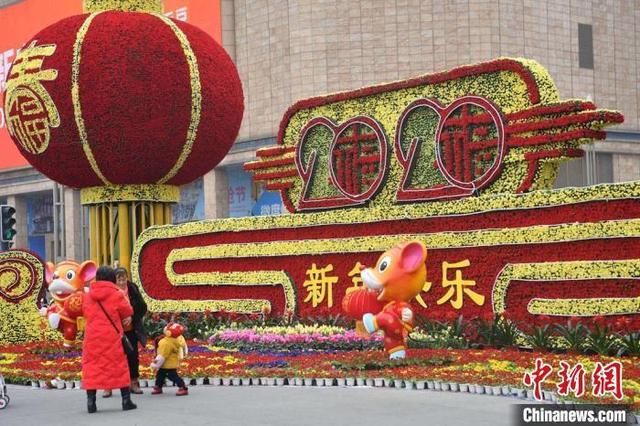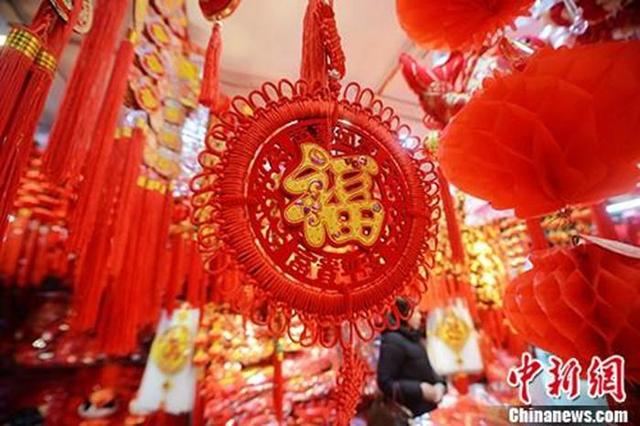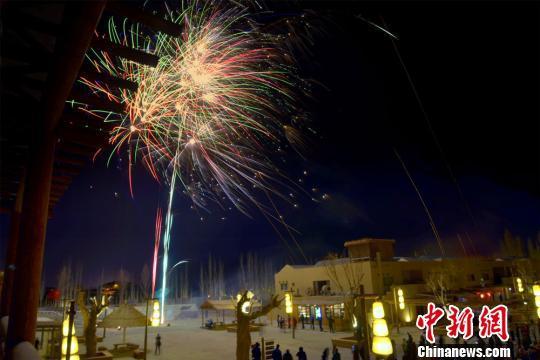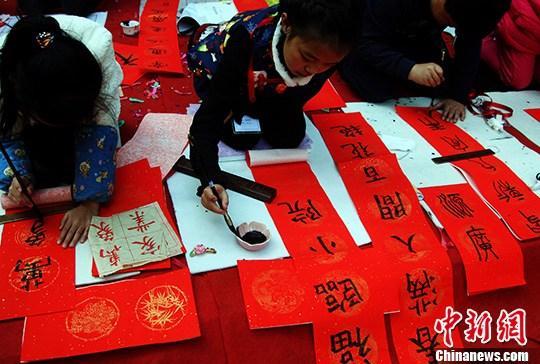Beijing, January 1st (Reporter Shangguan Yun) Today is January 1st, and many countries call it New Year’s Day. It represents the beginning of a new year and is a cheerful festival in people’s minds.
Interestingly, in ancient China, "New Year’s Day" originally referred to the current Lunar New Year, and there were other names such as "Duanri" and "Yuanzheng". The determination of names and dates such as "Spring Festival", "New Year" and "New Year’s Day" has also gone through a long evolution process.
What is the meaning of the word "New Year’s Day" in ancient times?
Speaking of New Year’s Day, if interpreted literally, it can be understood as "the first day".

Data Map: On December 31, 2019, Chengdu Tianfu Square was decorated with various flowers to welcome the arrival of New Year’s Day in 2020. Zhang wave photo
The "yuan" of "New Year’s Day" means beginning and first, and the beginning of every number is called "yuan"; "Dan" is an pictograph, with the upper "Sun" representing the sun and the lower "One" representing the horizon. Together, it symbolizes that the sun rises from the horizon in Ran Ran and a new day begins.
Therefore, people combine the words "Yuan" and "Dan", which means the first day of the new year. It is said that New Year’s Day is also called "three yuan", that is, the yuan of the year, the yuan of the month and the yuan of the time.
One yuan initial, Vientiane update. In ancient times, New Year’s Day was highly valued. In the Jin Dynasty, there was a poet named Xin Lan who wrote a poem "Yuan Zheng": "Yuan Zheng opens the ceremony, and Jiaqing celebrates itself. Xian played for thousands of years, and Xiao Datong was happy. " It is the lively scene of New Year’s Day at that time.
When did the ancient "New Year’s Day" originate?
In fact, the "New Year’s Day" in ancient China is said to have originated in Zhuan Xu, one of the three emperors and five emperors, with a history of several thousand years. It is recorded in the Book of Jin: "Zhuan Di took the first month of Meng Xia as the yuan, which actually coincided with the Spring of New Year’s Day".
Although the meaning of "New Year’s Day" means the first day of the year has never changed, due to calendar reasons, the calculation method of the first day of the first month was not very unified before Emperor Wu of the Western Han Dynasty, and the months and days of New Year’s Day in previous dynasties were also inconsistent.

Data map. Photo by Meng Delong
For example, the Xia Dynasty in ancient times used the Xia calendar, which took Meng Xiyue (January) as the first month, but in Shang Dynasty, the Yin calendar used in Shang Dynasty took the twelfth month (December) as the first month, and the Zhou Dynasty’s weekly calendar took the winter month (November) as the first month.
After Qin Shihuang unified China, he decided to take Yangchunyue (October) as the first month, that is to say, the "New Year’s Day" at this time became "the first day of October".
It was not until the period of Emperor Wu of the Han Dynasty that the state of "changing and changing" basically ended: in the first year of Emperor Wu of the Han Dynasty, Deng Ping and others founded the "taichu calendar", redetermining Meng Xiyue (January) in the summer calendar as the first month, and calling the first day of Meng Xiyue (the first day of the first month in the summer calendar) New Year’s Day, which was used until the end of the Qing Dynasty.
The origin of the name "Spring Festival"
Time came to 1912, and in January of that year, Sun Yat-sen issued the Order of the Provisional President on Promulgating the Almanac, requiring the Ministry of Internal Affairs to compile a new almanac, and then stipulated that January 1st of the Gregorian calendar was "New Year’s Day", but it was not called "New Year’s Day".
As a result, there are two calendar systems in China: one is the official "solar calendar" as the time standard for public administration and international communication; One is the "lunar calendar" used in traditional society, which serves agricultural time and daily life.

Data Map: A desert bonfire party celebrating New Year’s Day was held in Yueyaquan Town, Dunhuang. Photo by Wang Binyin
In January 1914, the Ministry of Internal Affairs of the then government put forward in a submission to the President: "It is proposed to designate New Year’s Day in the lunar calendar as the Spring Festival, Dragon Boat Festival as the summer festival, Mid-Autumn Festival as the autumn festival, and Winter Solstice as the winter festival …" Later, only "New Year’s Day as the Spring Festival" was approved, so the traditional Chinese New Year was renamed as "Spring Festival" and the traditional name of "New Year’s Day" was put on January 1 of the Gregorian calendar.
However, Xiao Fang, a folklore expert, said that although the government at that time had been promoting the Gregorian calendar, it even forced people not to celebrate the old calendar and prohibit folk activities such as posting Spring Festival couplets, but the people did not buy it, and their daily lives continued according to the old calendar.
On September 27th, 1949, the first plenary session of the China People’s Political Consultative Conference passed the "People’s Republic of China (PRC) calendar adopts the AD calendar method", and the first day of the first lunar month is called the Spring Festival, and January 1st of the Gregorian calendar is designated as the New Year’s Day. At this point, "New Year’s Day" has become a festival celebrated by people, and the traditional annual festival has also received due attention.
What did you eat on New Year’s Day in ancient times?
"New Year’s Day in Four Seasons, Long Life in Early Spring" always brings people new expectations, and the ancient New Year’s Day court has a grand New Year’s greeting ceremony. In the Three Kingdoms period, Cao Zhi wrote a poem in Yuan Hui: "At first, Yuan You, in ancient times, was only good, and it was a good meeting, so I gave a banquet here."

Data Map: New Year’s Day activities were held in Kunming Jindian Scenic Area, the bell tower rang the bell for blessing in the New Year, and hundreds of children wrote Spring Festival couplets, camellia exhibitions and other activities to wish happiness and well-being in the new year. China News Service reporter Li Jinhong photo
There is a saying that similar activities such as celebrating ceremonies and praying for sacrifices in the past dynasties originated from the "wax sacrifice" in ancient society, which mainly sacrificed crops and harvested gods, such as the god of agriculture. In the era of low social productivity, people should thank the "gods" and ancestors for their protection at the beginning of the new year and pray for a good weather in the coming year.
At this time, the diet is also rich and colorful, which is clearly described in "Jingchu Age". For example, when New Year’s Day arrived, the worship of congratulations in Jingchu area was completed in the Southern Dynasties, followed by the introduction of pepper and cypress wine, peach soup, Tu Su wine, gum tooth jar and spiced dish. Apply it to powder, take the ghost pill, and eat an egg each …
Count carefully, including drinks, food and drugs, each with its own meaning. In ancient times, on New Year’s Day, people performed a set of customs step by step and were very busy.
Chen Xianzhang, a poet in the Ming Dynasty, mentioned in his New Year’s Day Trial Pen: "The neighboring wall whirls to entertain guests, and the children sing songs and enjoy the New Year’s poems." Like a "Happy New Year Picture", it depicts the scene of people celebrating the traditional New Year. (End)
Reporting/feedback